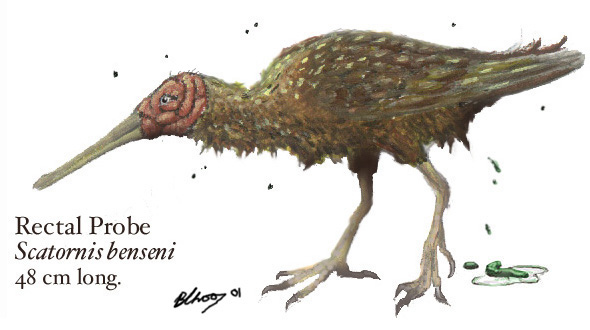

(Picture by Brian Choo)Fig.1: A portrait of the Rectal Probe.The Rectal Probe is a link in a grand chain of life that binds pseudosauropod, bird, bacteria, fungi, protist, platyhelminthian, annelid, mollusc, fish and amphibian in one glorious whole. This bird is a primitive charadriiform bird that has become specialised in feeding upon the various small organisms associated with the colon and cloaca of the aquatitan, a giant semiaquatic pseudosauropod dinosaur.
For many seemingly insignificant animals, the bowels of an aquatitan are heaven on Earth, being warm, sheltered and moist. By the time an aquatitan approaches adolescence, it's digestive tract is already home to a multitude of protists, flukes, planarians, tapeworms and nematodes. However, it is the actions of a bird and a larval amphibian that opens up the colon to larger colonists.
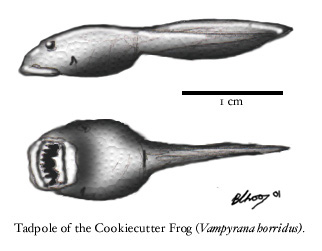 (Picture by Brian Choo)Fig.2: The Cookiecutter Tadpole. The first in a succession of aquatic vertebrates to enter and eventually colonise the Aquatitan's lower colon.
(Picture by Brian Choo)Fig.2: The Cookiecutter Tadpole. The first in a succession of aquatic vertebrates to enter and eventually colonise the Aquatitan's lower colon.The tadpole of the Cookiecutter Frog (a small ectoparasitic amphibian of swamp-dwelling dinosaurs) is a voracious carnivore with a formidable set of jaws that swarm around aquatitans, attacking molluscs, fish and other tadpoles that feed on algae growing on the dinosaur's hide. They also have the disturbing habit of gnawing their way into the cloaca and leaving with a mouthfull of flesh.
Understandably, the aquatitans find this behaviour alarming, particularly the younger animals. They will often storm out of the water, in doing so stranding dozens of their tiny tormenters in their rectum. This is the cue for the rectal probes which flock around the dinosaur's cloaca, probing with their long bills to extract and eat the wriggling, gnashing tadpoles.
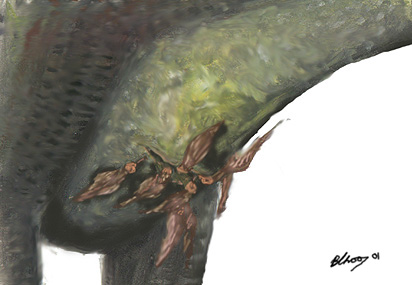 (Picture by Brian Choo)
(Picture by Brian Choo)
Fig. 3: Rectal Probes earning their name on an Aquatitan's rear-end.While their activities provide short-term relief, the rectal probes prove a mixed blessing. The birds' saliva contains an irritant toxin that causes
the soft flesh of the cloaca and colon to break out into large red sores which eventually become calloused. Additionally, abrasions caused by the birds' probing bills combined with wounds inflicted by the tadpoles become the source of fungal and bacterial growths. Fortunately the Aquatitan has evolved a secondary valve deeper in the colon which prevents infection and parasites from spreading into the intestines and reproductive organs.The effect of all this biological activity is that the lower colon, outside the protection of the secondary valve, becomes more oxygenated and is accessible to a wide variety of aquatic animals. The callouses prevent the cloaca from creating a watertight seal and provides a series of grottos where small animals can shelter to avoid being crushed of smothered during fecal expulsion. It also greatly increases the surface area for fungal growth.
Soon a whole succession of water animals invade the lower colon, some taking up semi-permanent residence. Leeches and parasitic fish fasten themselves to the walls of the colon, sucking blood. Snails, planarians and catfish graze on fungal tufts and faeces. Predatory fish and crustaceans dart from colon-to-colon, snapping up prey. The diversity of life in just one aquatitan's colon is nothing short of staggering.
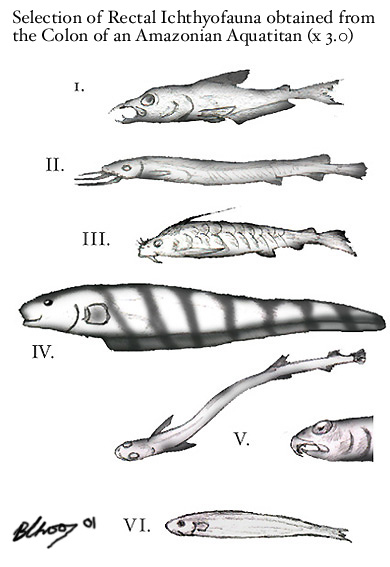 (Picture by Brian Choo)
(Picture by Brian Choo)
Fig. 4: All these fish were removed from just a single Aquatitan's colon.Many of these species are becoming increasingly popular in the pet trade and fibreglass/rubber "dino-bowel" units are now marketed for those wishing to create an accurate biotype aquarium.
I. Bigfang Tetra (Characosphyraena srnkai) : characoid. endo/ectoparasite &
predator.II. Dinocandiru (Dinocandiru burgessi) : Ostariophysi incertae sedis.
(derived catfish or gonorynchiform). Endoparasite. Uses prong like barbels
to puncture flesh and access the blood vessels.III. Bowelsucker (Aumatichtys armatus) : catfish, herbivore & detritivore.
IV. Bungholio Knifefish (Microgymnotus botoi) : gymnotid, predator.
V. Sabretooth Wriggler (Vampyrogobius belli) : Paracanthopterygii incertae
sedis. endoparasite.VI. Crapdigger (Scatichthys chooi) : Actinopterygii incertae sedis.
detritivore. burrows in dung to feed on tapeworm eggs.All this bustle proves to be of benefit to the aquatitan in crowding out more harmful forms like the cookiecutter tadpole. Even the parasitic forms do comparatively little damage to the giant dinosaurs. And, whenever the pseudosauropod leaves the water, it leaves the inhabitants of it's colon high and dry; a feast for the ravenous rectal probes.
These remarkable birds play one final role in the great circle of life. Whenever an aquatitan relieves itself (either in the water or on land - the dung floats), the probes immediately swarm on the dropping, tearing at the dung in a frantic search for dislodged rectal animals. In doing so their feathers become caked with both dung and the eggs of a whole host of creatures - tapeworms, flukes, molluscs, even fish. Thus, even as they consume the adult parasites, the birds act as a transportation vector for their offspring, carrying them to new bodies of water and new pseudosauropod digestive tracts.
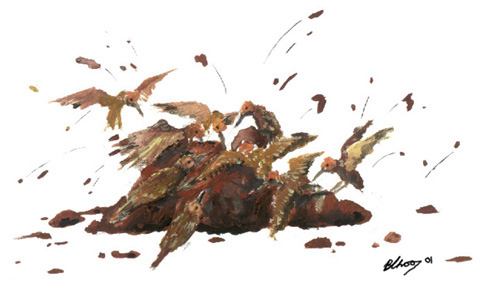 (Picture by Brian Choo)Fig. 5: Rectal Probes rolling in poo.
(Picture by Brian Choo)Fig. 5: Rectal Probes rolling in poo.